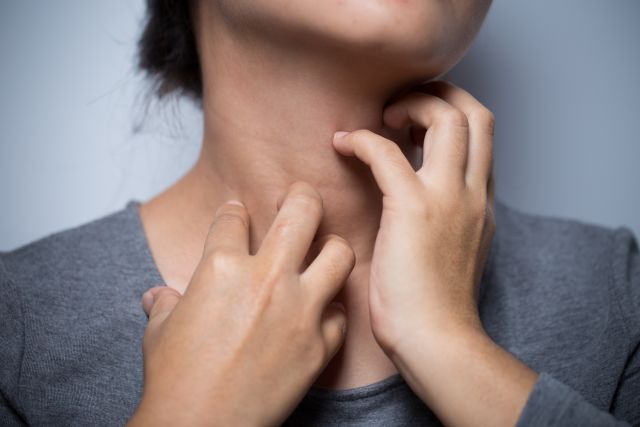Updated on June 21, 2024.
Whether shrimp makes you itchy or eggs give you hives, you’re in good company. Food allergies affect around 33 million Americans, according to the nonprofit organization Food Allergy Research & Education (FARE).
Food allergies are a growing issue, too—especially for children. In 2021, 5.8 percent of kids ages 0 to 17 were reported to have a food allergy, according to the Centers for Disease Control and Prevention (CDC). Some estimates put the number as high as 8 percent. That’s up from 4 percent in 2007.
So, what is a food allergy, exactly?
Understanding food allergies
In a nutshell, a food allergy is an immune response. It occurs when your body’s defense system overreacts to a food protein (or allergen) that would normally be harmless.
“Food allergies can involve a few organs like the skin, the lungs, and the gastrointestinal (GI) tract,” says Marvin Rios, MD, a pediatrician affiliated with Kendall Regional Medical Center in Miami, Florida. He adds that food allergies are different from a food intolerance, which does not trigger the immune system. "Most of the time, a food intolerance is limited to the GI tract,” he notes.
Here’s what you need to know about these potentially serious medical conditions.
The top nine common food allergies
Though food allergies can develop in adults, most begin during childhood. A person can become allergic to any food, and many patients react to more than one. In the United States, 90 percent of food allergies are caused by just nine foods. Their presence must be clearly identified on all food packaged in America, in accordance with the Food Allergen Labeling and Consumer Protection Act (FALCPA) of 2004. The most common foods for allergies are:
- Cow’s milk
- Eggs
- Peanuts
- Tree nuts (cashews, almonds, walnuts, etc.)
- Soy (soy milk, soy sauce, edamame, etc.)
- Fish (tuna, salmon, tilapia, etc.)
- Shellfish (crabs, shrimp, lobster, etc.)
- Wheat (note that a wheat allergy is different from Celiac disease and gluten sensitivity)
- Sesame
By age 5, up to 9 in 10 children outgrow allergies to milk, eggs, wheat, and soy. About 1 in 5 will outgrow a peanut allergy, as well, though most people with allergies to peanuts, tree nuts, fish, and shellfish typically have them for life. You’re much more likely to grow out of an allergy if you develop it as a child, rather than as an adult.
The food most recently added to the list of top causes of food allergies is sesame, as part of the federal Food Allergy Safety, Treatment, Education, and Research (FASTER) Act passed in 2021. As of January 1, 2023, sesame is required by the U.S. Food and Drug Administration (FDA) to be included as an allergen on packaged foods labels. One study published in 2019 in JAMA Network Open suggested that up to 1.6 million Americans could be allergic to the seed and its derivatives, including sesame oil and tahini.
“I see a lot of people with sesame allergies,” says Dr. Rios, “and there's a lot of food that contains sesame, like bagels, gyros, snack bars, and pretzels.” Sesame is also a common ingredient in hummus, baked goods, and Asian cuisine.
Symptoms of an allergic reaction
When you eat something that you’re allergic to, it can trigger a wide variety of food allergy symptoms, from mild to potentially fatal.
“Runny nose, stuffy nose, sneezing—that will be the mild cases,” says Rios. “And of course, hives. That's one of the main symptoms.”
Mild to moderate allergic reactions may also involve one or more of the following:
- Eczema or skin rash
- Redness and/or itching around the mouth
- Itching and/or metallic taste in the mouth
- Red and/or itchy eyes
- Coughing
- Nausea, vomiting, cramps, diarrhea, or abdominal pain
These symptoms often pop up within minutes, though they can take hours to appear. Reactions that seem minor at first can worsen, fast. Food allergy symptoms can also differ from episode to episode. In other words, eating eggs may cause itching one time and breathing problems the next.
Milder food allergies are often treated with antihistamines, which can ease symptoms quickly. Severe food allergies, on the other hand, require different treatment. Signs of a serious reaction include:
- Swelling of the face, eyes, mouth, or throat
- Wheezing or breathing problems
- Pale or blue skin
- Chest pain
- Drop in blood pressure or light-headedness
- Loss of consciousness
- Weak and rapid pulse
One or more of these severe symptoms—which can appear along with milder symptoms—may indicate anaphylaxis, a fast and potentially fatal allergic reaction. Epinephrine is the primary treatment. An injection must be given as soon as possible, using a device commonly called an EpiPen. Afterward, you’ll need to dial 911 or get to a nearby emergency department for medical assessment, additional treatment, and monitoring.
Diagnosing a food allergy
If you or a loved one experience unusual symptoms after eating a particular food, or you suspect an allergy, book an appointment with your healthcare provider (HCP). They can help identify a possible issue and point you toward a board-certified allergist for further evaluation. Do not diagnose yourself or your child, since food allergies are complicated medical conditions.
To help reach a diagnosis, an HCP will first get your medical and family history and do a physical examination. Additional tests often include a blood test and skin-prick test. An oral food challenge, during which you’re given a little bit of allergen and then observed for a reaction, is also used to identify a food allergy.
You may be put on an elimination diet, as well, during which you stop eating certain foods and then gradually reintroduce them. This can help HCPs pinpoint your specific triggers.
Preventing future reactions
While they may fade over time, food allergies have no cure. The best way to prevent symptoms is simply avoiding the food. Take care to read nutrition labels and teach kids how to decipher them. Show them where the top nine allergens are typically listed.
At home, separate and label troublesome foods. If someone in the family has a severe allergy, consider designating special dishes, utensils, and cooking vessels. At restaurants, make sure to ask servers about allergens in dishes. Some people even carry Chef Cards to communicate their dietary issues.
To help avoid an allergic reaction at school, communicate with your child’s teachers and school staff before each year begins. Work together on developing an emergency action plan that highlights prevention, recognition of symptoms, and response. Make sure the school nurse has any appropriate medication. Depending on your child’s age, maturity level, and local laws and policies, they may also carry medication themselves.
Finally, be prepared. If you can’t already identify it, learn what an anaphylactic reaction looks like.
“It is mandatory that patients know how to recognize life-threatening symptoms and know what to do in that case,” says Rios.
People with serious allergies may be advised to carry medication when they’re out and about. If you’ve been prescribed epinephrine, it’s a good idea create two emergency kits: one for home and one for when you leave the house. Reach out to your HCP or allergist with questions or problems.







